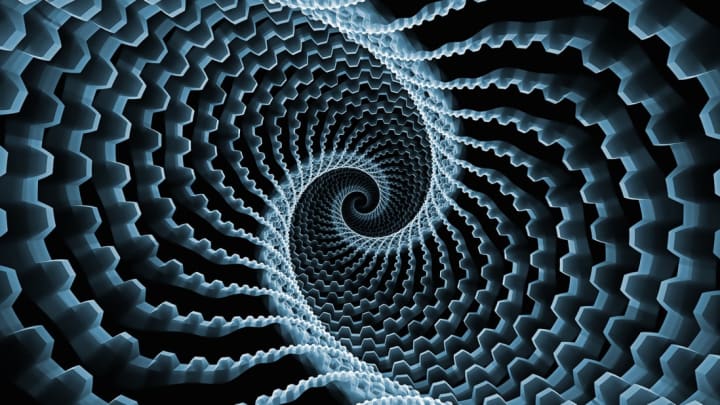What Is Infinity?

Albert Einstein famously said: “Two things are infinite: the universe and human stupidity. And I'm not sure about the universe.”
The notion of infinity has been pondered by the greatest minds over the ages, from Aristotle to German mathematician Georg Cantor. To most people today, it is something that is never-ending or has no limit. But if you really start to think about what that means, it might blow your mind. Is infinity just an abstract concept? Or can it exist in the real world?
THERE'S MORE THAN ONE KIND
Infinity is firmly rooted in mathematics. But according to Justin Moore, a math researcher at Cornell University in Ithaca, New York, even within the field there are slightly different uses of the word. “It's often referred to as a sort of virtual number at the end of the real number line,” he tells Mental Floss. “Or it can mean something too big to be counted by a whole number.”
There isn't just one type of infinity, either. Counting, for example, represents a type of infinity that is unbounded—what's known as a potential infinity. In theory, you can go on counting forever without ever reaching a largest number. However, infinity can be bounded, too, like the infinity symbol, for example. You can loop around it an unlimited number of times, but you must follow its contour—or boundary.
All infinities may not be equal, either. At the end of the 19th century, Cantor controversially proved that some collections of counting numbers are bigger than the counting numbers themselves. Since the counting numbers are already infinite, it means that some infinities are larger than others. He also showed that some types of infinities may be uncountable, as opposed to collections like the counting numbers.
"At the time, it was shocking—a real surprise," Oystein Linnebo, who researches philosophies of logic and mathematics at the University of Oslo, tells Mental Floss. "But over the course of a few decades, it got absorbed into mathematics."
Without infinity, many mathematical concepts would fall apart. The famous mathematical constant pi, for example, which is essential to many formulas involving the geometry of circles, spheres, and ellipses, is intrinsically linked to infinity. As an irrational number—a number that can't simply be expressed by a fraction—it's made up of an endless string of decimals.
And if infinity didn't exist, it would mean that there is a biggest number. "That would be a complete no-no," says Linnebo. Any number can be used to find an even bigger number, so it just wouldn't work, he says.
CAN YOU MEASURE THE IMMEASURABLE?
In the real world, though, infinity has yet to be pinned down. Perhaps you've seen infinite reflections in a pair of parallel mirrors on opposite sides of a room. But that's an optical effect—the objects themselves are not infinite, of course. "It's highly controversial and dubious whether you have infinities in the real world," says Linnebo. "Infinity has never been measured."
Trying to measure infinity to prove it exists might in itself be a futile task. Measurement implies a finite quantity, so the result would be the absence of a concrete amount. "The reading would be off the scale, and that's all you would be able to tell," says Linnebo.
The hunt for infinity in the real world has often turned to the universe—the biggest real thing that we know of. Yet there is no proof as to whether it is infinite or just very large. Einstein proposed that the universe is finite but unbounded—some sort of cross between the two. He described it as a variation of a sphere that is impossible to imagine.
We tend to think of infinity as being large, but some mathematicians have tried to seek out the infinitely small. In theory, if you take a segment between two points on a line, you should be able to divide it in two over and over again indefinitely. (This is the Xeno paradox known as dichotomy.) But if you try to apply the same logic to matter, you hit a roadblock. You can break down real-world objects into smaller and smaller pieces until you reach atoms and their elementary particles, such as electrons and the components of protons and neutrons. According to current knowledge, subatomic particles can't be broken down any further.
THE INFINITIES OF THE SINGULARITY
Black holes may be the closest we've come to detecting infinity in the real world. In the center of a black hole, a point called a singularity is a one-dimensional dot that is thought to contain a huge mass. Physicists theorize that at this bizarre location, some of the singularity's properties are infinite, such as density and curvature.
At the singularity, most of the laws of physics no longer work because these infinite quantities "break" many equations. Space and time, for example, are no longer two separate entities, and seem to merge.
According to Linnebo, though, black holes are far from being an example of a tangible infinity. "My impression is that the majority of physicists would say that is where our theory breaks down," he says. "When you get infinite curvature or density, you are beyond the area where the theory applies."
New theories may therefore be needed to describe this location, which seems to transcend what is possible in the physical world.
For now, infinity remains in the realm of the abstract. The human mind seems to have created the concept, yet can we even really picture what it looks like? Perhaps to truly envision it, our minds would need to be infinite as well.